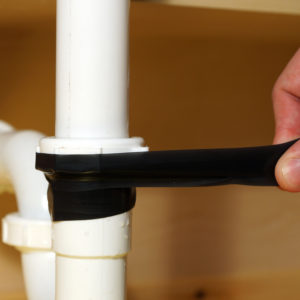
No one wants to think about it, but a pipe can rupture at any time. Any time. If you’re very lucky, it’ll be during your local plumber’s business hours and they will be able to fit you into their schedule – after-hours or emergency calls almost always cost more than regularly scheduled appointments. So what are your options if you’re unlucky, and your pipes spring a leak at 2am on a weekend? One option is to attempt an emergency repair yourself. The following methods will hopefully provide a temporary repair to the leak, keep your water running, and allow you time to arrange for a plumber to come for a real fix.
First things first…
The first thing to do is shut off your water supply. Once this is done, turn on the faucet at the lowest point from the pipe to drain any remaining water, and relieve any pressure. Clean off the damaged area of pipe and wipe it dry.
Be extremely careful when handling the pipe, and when performing your short-term repairs – the pipe may be more damaged than it appears and could potentially collapse or break when handled.
Simple Short-Term Repair
For very small holes (“pinholes”), wrap electrical or duct tape around the pipe a few times, and keep it tight using hose clamps at both ends of the tape. This is a quick and very temporary fix – about long enough for you to get a hold of an emergency plumber. Depending on the hole and the condition of the pipe, it may look like this “fix” will hold up for a day or two – don’t let yourself be fooled! Repair the pipe posthaste.
If the hole is a bigger one or you have a leak at a fitting joint, epoxy putty is a versatile and easy way to plug it. Sold in almost any home improvement store, it usually comes in a two-part “stick” form, and is activated by kneading the two component materials together. After the section of pipe has been cleaned and dried, put on a pair of gloves, break off a suitably-sized chunk of the epoxy, and prepare it. Work the putty into the hole and around it, using a putty knife if necessary to guarantee smooth coverage. Let the epoxy cure according to the manufacturer’s directions (usually under an hour). Once fully hardened, turn the water back on and check for leaks. Re-apply if necessary.
If you don’t have any epoxy lying around, or the store is closed, you can use hose clamps to effect a temporary fix. This simple technique uses hose clamps and a patch of rubber – an old bicycle inner tube will work, as will a length of old garden hose – to patch the hole and create enough pressure to keep it from bursting. All you need to do is cut a large enough piece of rubber/inner tube/garden hose to cover the hole and an area a few inches around it. Depending on the size of the hole, you may be able to seal it off using only one clamp, or you may need one around each end and in between as necessary. Although superior to using tape and clamps, this method is another that should not be tested for long.
A product designed specifically for these situations is the pipe repair clamp. These consist of two metal plates, often include a rubber sheath, and function in the same basic way as the hose-clamp solution. Once the plates are placed over the hole and around the pipe, they are tightened together with screws. Some repair clamps can act as a permanent fix provided the rest of the pipe is in good condition. The pipe repair clamps we offer include a rubber sheath, and can function as either a temporary or longer-term repair depending on your situation.
Should neither of these options be available to you, but you do have a C-clamp, you’re still in good shape. After cutting out a piece of rubber to cover the hole with, take a wood block and place it over the rubber: this will spread the pressure of the clamp, keeping it from collapsing the pipe. A second block can be used if you’re worried that the walls of your pipe may be too thin to take the pressure. Tighten the clamp until contact is made with the wood blocks (or one wood block and pipe), then only about 1/4 or 1/2 turn further. Once the clamp is tightened, the leak should be sealed off. Turn the water on and check for leaks. If the 1/4 or 1/2 turn more doesn’t stop the leak, you may need to reposition the patching material and try again.
If you are looking for a East Dundee Plumber or plumber in the surrounding area, call Euro Plumbing & Sewer today at (224) 678-9966. With our “On Time Guarantee” we will provide the highest quality service on your schedule! We are also a 24/7 emergency plumbing & sewer company, we can help no matter the day or time.
